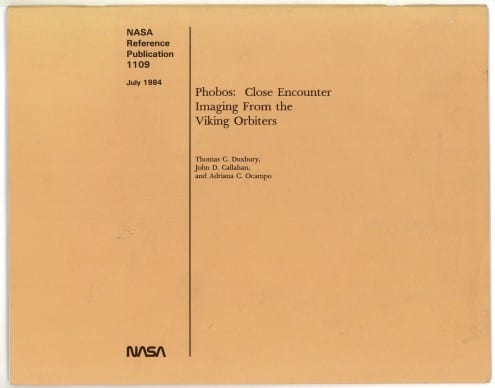The LHCb experiment
By Oli Usher, on 22 September 2014

The LHCb experiment. Credit: CERN (licence)
This week’s Picture of the Week is the LHCb (Large Hadron Collider beauty) experiment at CERN. Located in a cavern on the the French side of the Circle Line-sized cross-border particle accelerator, LHCb is as big as a house. The detector investigates why our universe is dominated by matter, rather than antimatter.
Prof Nick Brook, the newly appointed Dean of Mathematical & Physical Sciences at UCL, was the computing project leader on the LHCb experiment during the vital period leading up to first data taking. He joins joins a wide range of other CERN researchers based here.
Jon Butterworth, UCL’s head of physics, will give a public talk about his role at CERN and the discovery of the Higgs Boson on 15 October. Click here for more information.
High resolution image
- A high resolution image is available from the CERN Document Server
This picture may be reproduced providing you follow the conditions of the CERN licence.
Rosetta landing site chosen
By Oli Usher, on 15 September 2014

The landing site for Philae, the lander component of the Rosetta mission, has been chosen and is marked here with a white cross. Photo credit: ESA
The Rosetta mission, which for the past decade has been on a long and convoluted journey to Comet C-G, has recently reached its destination. It is the only artificial object ever to enter orbit around a comet, and is currently circling around it at an altitude of around 30km. (The cometary nucleus itself is around 4km across.)
Part of Rosetta’s mission is to measure the properties of the plasma (electrically charged gas) that surrounds the comet. To this end, the spacecraft features a suite of five sensors built by the Rosetta Plasma Consortium, a scientific collaboration that includes UCL’s Prof Andrew Coates.
But as well as measuring the plasma around the comet, Rosetta will attempt something never achieved before: it will release a lander that, later this year, will touch down on the comet’s surface. The European Space Agency has today announced the site that the lander, known as Philae, will aim for: a spot known as Site J, pinpointed in the photo above with a white cross. The landing site was chosen as the best compromise between safety (the surface of the comet is uneven in places and could damage the probe) and scientific interest (some parts are more active than others).
Copyright: ESA images are free to use providing they are credited, do not imply endorsement by ESA, do not feature identifiable individuals, and are not used in advertising or promotional materials.
Links
High resolution images
Close encounters with fear and dread
By Oli Usher, on 8 September 2014
This week’s Picture of the Week comes from UCL’s planetary science archives, and their rich collection of early NASA space images. Many of these are not available anywhere online, and some of them are hidden behind rather unpromising covers (see above).
The Viking missions to Mars, two identical spacecraft launched a few weeks apart in 1975, are well known for making the first successful landings on the surface of the red planet. But the Viking orbiters were important too, mapping the surface of the planet and observing its moons, Phobos (fear) and Deimos (dread).
This NASA book from 1984, entitled Phobos: Close Encounter Imaging from the Viking Orbiters is a comprehensive album of the observations the programme made of Phobos, the larger of the two moons.
This picture shows a typical spread, produced during the flyby of Phobos on May 26, 1977 by Voyager Orbiter 1.
Although it is the larger of the two moons of Mars, Phobos is still very small, and seems likely to be an asteroid captured by Mars’ gravity, rather than a moon formed at the same time as its parent planet.
A fraction of the size of Earth’s Moon, its gravity is not strong enough to have pulled it into a sphere, leaving the irregularly-shaped object visible here.
A Russian mission to land on Phobos and return a sample to Earth, Fobos-Grunt, malfunctioned shortly after launch in November 2011 and never left Earth orbit.
Links
- UCL Regional Planetary Image Facility
- Snapshots from Space History (more photos from UCL’s planetary science archives)
- UCL Centre for Planetary Sciences
- Videos and photos of Phobos and Deimos seen from the Martian surface, taken by the Curiosity Rover
High resolution image
Mapping the light of the cosmos
By Oli Usher, on 1 September 2014
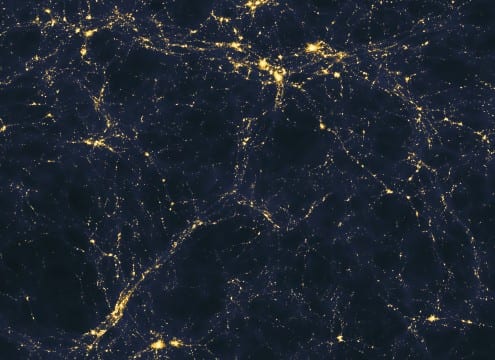
This image shows one possible scenario for the distribution of light in the cosmos. Photo credit: Andrew Pontzen/Fabio Governato
Figuring out what the structure of the universe is surprisingly hard. Most of the matter that makes up the cosmos is totally dark, and much of what is left is in tiny, dim galaxies that are virtually impossible to detect.
This image shows a computer simulation of one possible scenario for the large-scale distribution of light sources in the universe. The details of how light (and hence galaxies and quasars) is distributed through the cosmos is still not a settled question – in particular, the relative contributions of (faint but numerous) galaxies and (bright but rare) quasars is unknown.
(New research from UCL cosmologists published last week shows how we should be able to find out soon.)
However, astronomers know that on the largest scales, the universe is structured as a vast web made up of filaments and clusters of galaxies, gas and dark matter separated by huge, dark voids. Observational astronomy is making strides forward in mapping out these structures in gas and light, but the smallest galaxies – less than a pixel across in the image above – might never be seen directly because they are simply too faint.
A Hubble image of a nearby faint dwarf galaxy (right) shows the challenge involved in observing these objects even when they are in our galaxy’s vicinity.
These computer models are one way of trying to extrapolate from what we know to what is really there. New research from UCL now shows how we can also use future observations of gas to find out more about this elusive population of tiny galaxies.
This simulated image shows the distribution of light in an area of space over 50 million light-years across. The simulation was created by Andrew Pontzen of UCL and Fabio Governato of the University of Washington.
Links
- UCL Physics & Astronomy
- UCL News story on finding the origin of the universe’s light
- In depth profile of the research on the UCL Mathematical & Physical Sciences website
High resolution image
Why art, not science, deserves credit for these pioneering dinosaur reconstructions
By Oli Usher, on 26 August 2014
A century and a half ago, Britain was swept by dino-mania. The discoveries of ancient fossils and the first characterisations of dinosaur species, combined with new scientific theories that posited that the Earth was far older than previously thought, fuelled a fascination with all things ancient.
A concrete example of this period is still visible today, in the form of the dinosaur statues in Crystal Palace Park. These date to 1854 and were built for the reopening of the Crystal Palace in Sydenham, when it was rebuilt there following the 1851 Great Exhibition in Hyde Park
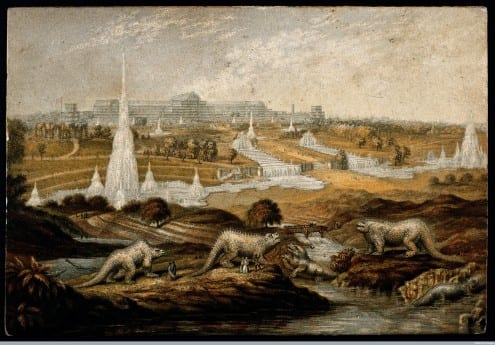
The Crystal Palace Dinosaurs circa 1854, by George Baxter. Picture credit: Wellcome Library (CC-BY)
A naïve view of these is that they are a quaint, even amusing, example of how ignorant the Victorian scientists were – the statues predate Darwin’s theory of evolution by five years, and in some cases they bear little resemblance to the animals they claim to represent.
Joe Cain (professor of history and philosophy of biology in UCL Science and Technology Studies) has studied the statues’ history and says that naïve view is nonsense. The scientific origins of these statues is far more nuanced and interesting – and in any case, the credit for them lies with the sculptor, Benjamin Waterhouse Hawkins, far more than it does with the zoologist Richard Owen, who supposedly directed their design.
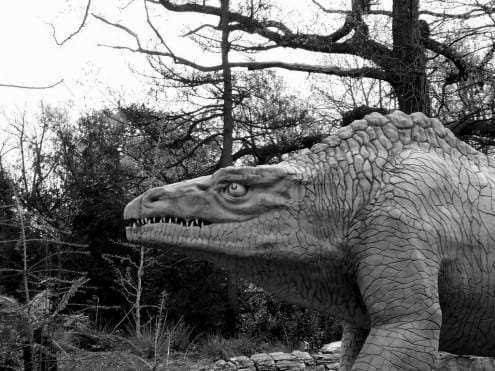
Megalosaurus, one of the statues at Crystal Palace Park. Photo credit: O. Usher (UCL MAPS) (CC-BY)
***
Hawkins was a scientific illustrator, an experienced translator of scientific ideas. Owen was just one of several sources he consulted, and Hawkins kept up with the rapidly expanding literature of the animals he was working to model for his displays. Hawkins even represented competing theories of reconstruction in his statues. There are two Iguanodon statues, for instance. One is long, low and lizard-like; the other is stocky and raised on its four legs, more like a hippopotamus or rhinoceros.
There is plenty to show that the artist wasn’t merely doing what he was told, but was actively interpreting the scientific evidence.
There also is plenty that science didn’t (or, couldn’t) tell him. Even more than today, the Victorians had only partial specimens, made of various bones of various origins and in various conditions, leaving Hawkins to fill very large gaps. On top of this, Hawkins had to invent elements such as pose, movement, and facial expressions. None of these could be gleaned even from perfectly preserved and well-understood fossils.
Given the uncertain (and disputed) scientific theories, the limited selection of fossils to work from, and the inevitable necessity of artistic licence, Cain thinks the dinosaur statues are something to admire rather than ridicule.
In any case, while some of his statues, are quite different from today’s reconstructions…

Hawkins’ Megalosaurus (left) doesn’t look much like modern reconstructions. Photo credit: CGP Grey (CC-BY) and Mariana Ruiz (public domain)
…others, such as his plesiosaur, are remarkably similar to what we have now.
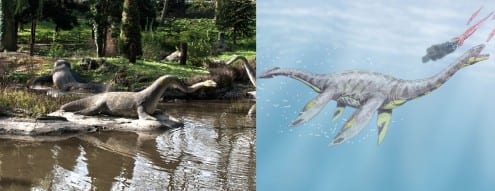
Hawkins’ plesiosaur (left) and a modern artist’s impression (right). Photo credit: Berlt Watkin (CC-BY) and Dmitry Bogdanov (CC-BY)
***
Cain’s interpretation of how the Crystal Palace Dinosaurs came about rings very true to me. In a previous life I worked with some of the people who prepare scientific visualisations, animations and artists’ impressions for the Hubble Space Telescope. The case of HD 189733b – a planet that was observed being scorched by a stellar flare (among other research) – is remarkably similar to the dinosaurs of Crystal Palace.
Much like Benjamin Waterhouse Hawkins, those animators had a great deal of scientific information they could draw on – on the size and brightness of the flare, on the optical properties of the atmosphere, on the colour of the star and its appearance. But as with the Crystal Palace Dinosaurs, these were just pieces of a puzzle, with plenty missing and some educated guesswork involved in putting them together.
The resulting animations are rather beautiful, and like with the dinosaurs, the artist deserves at least as much credit as the scientist does.
- The Friends of Crystal Palace Dinosaurs website has extensive information on the dinosaurs, where to visit them and the campaign to conserve them. Joe Cain is one of the leading members of the Friends, and sits on the group’s management board.
Kathleen Lonsdale interview
By Oli Usher, on 19 August 2014
If you don’t know who Kathleen Lonsdale was, you should.
Lonsdale was a hugely important chemist (in the field of crystallography), an outspoken political activist and president of what is now the British Science Association. She was also, from 1949, the first woman to become a professor at UCL.
BBC Woman’s Hour interviewed her in 1967, shortly before she retired from UCL. The programme, available on iPlayer, is well worth a listen.
Lonsdale retired from UCL in 1968, and died in 1971, but she is commemorated in the name of the Kathleen Lonsdale Building on Gower Place. This building houses many of UCL’s science labs.

Lonsdale is remembered in the name of the Kathleen Lonsdale Building, which houses many of UCL’s science labs. Photo: Gnesener1900 – CC-BY-SA
Thanks to Joe Cain for bringing this to our attention.
Photo album from the Dark Energy Survey
By Oli Usher, on 18 August 2014
The Dark Energy Survey, which has just begun its second year of observations, is gathering data about one of the most puzzling phenomena to be discovered in the past century: that the universe is not only expanding, but is doing so at an ever faster rate. Some as yet unknown force dubbed ‘dark energy’ is driving this acceleration.
Dark energy affects the appearance and evolution of the universe on very large scales. The Dark Energy Survey aims to find out more about this phenomenon by studying measuring four key cosmological probes:
- The number of galaxy clusters;
- The distances to faraway supernovae;
- The bending of light by gravitational lensing;
- and the pattern of the distribution of galaxy clusters across the universe.
Observing these requires sharp images that can detect very distant (and hence faint) objects, and so the the images collected by the Dark Energy Camera, the survey’s workhorse, are often quite stunning.
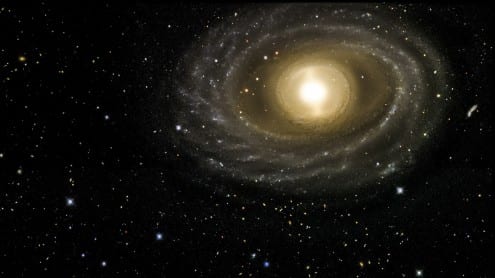
This image of the NGC 1398 galaxy was taken with the Dark Energy Camera. This galaxy lives in the Fornax cluster, roughly 65 million light-years from Earth. It is 135,000 light-years in diameter, just slightly larger than our own Milky Way galaxy, and contains more than a billion stars. Credit: Dark Energy Survey.
To mark the beginning of the second year of DES’s five-year observing run, the team have published a gallery of the most attractive images from the first year of operation, including the image of galaxy NGC 1398, pictured above. The complete the gallery is at the end of this post and in the faculty Flickr gallery.
UCL is deeply involved in DES, and Prof Ofer Lahav, Vice-Dean (Research) of Mathematical & Physical Sciences, is chair of the DES UK board and co-chair of the DES international science committee.
More information on UCL’s involvement in the DES science programme is available in an article on the UCL news pages.
Gallery
Copyright: Dark Energy Survey photos are free to use providing they are credited to the Dark Energy Survey. Any queries on reuse should be sent to Fermilab Visual Media Services at vismedsr@fnal.gov.
Links
High resolution images
The Fields Medal: a stepping stone for women in mathematics
By ucahhwi, on 14 August 2014
We heard yesterday that the Fields Medal, which is the closest thing to a Nobel Prize for Mathematics, has been awarded to a woman for the first time in its 78 year history.
The prize is awarded once every four years, to a small number of mathematicians (two to four each time) and is presented at the International Congress of the International Mathematical Union. This year’s winners are Artur Avila, Manjul Bhargava, Martin Hairer and Maryam Mirzakhani.
It’s fantastic to see a female mathematician rewarded at this very highest level for the first time. I hope the news coverage around this breakthrough will encourage women in mathematics at all levels. At the moment, there are plenty of girls studying maths in the UK up to degree level, which is wonderful. We may not be quite 50:50 but the proportions are close enough that girls don’t feel as if they’re in the minority. And that’s changed since I was a student. But as you move through the academic stages – PhD, postdoc, lecturer, professor – we have a “leaky pipeline” and at the top, only 6% of UK mathematics professors are female.
Here at UCL we had one of the first female maths professors in Susan Brown (who retired a few years ago); we’re proud of our heritage but our female academic staff are still badly outnumbered and there’s still a long way to go. Maybe this Fields Medal is one more stepping stone along the way for women in mathematics.
Watch Helen Wilson discuss the Fields Medal on BBC World News
Helen Wilson is Deputy Head of UCL Department of Mathematics
Why is there no Nobel Prize in mathematics?
By Oli Usher, on 13 August 2014
 Prof Mark Ronan (UCL Mathematics) asks a common question: why is there no Nobel Prize in Mathematics?
Prof Mark Ronan (UCL Mathematics) asks a common question: why is there no Nobel Prize in Mathematics?
The Fields Medal, awarded today to Artur Avila, Manjul Bhargava, Martin Hairer and Maryam Mirzakhani is sometimes compared to the Nobel Prizes, but it’s restricted to under-40s and exists to encourage research among (relatively) early-career mathematicians, not to recognise a lifetime’s achievement. (UCL has done rather well out of the Fields Medal in the past, with three winners among former staff and students.)
Writing in today’s Daily Telegraph, he ponders:
One explanation is that the Swedish mathematician Mittag-Leffler had an affair with Nobel’s wife. This sounds plausible, until one discovers that Nobel was unmarried. From Sweden I now hear a fanciful story that the attractive mathematician Sofia Kovaleskaya rebuffed Nobel’s advances. Yet she died in 1891 – years before his bequest.
Dawn of the neutrinos
By Oli Usher, on 11 August 2014
In Fermilab, just outside of Chicago, an intense beam of neutrinos leaves a particle accelerator. Less than one hundredth of a second later, the neutrinos reach Northern Minnesota, over 700 kilometres away. Here, scientists and engineers are developing a number of large experiments to help them understand the properties of neutrinos – currently an area of considerable uncertainty in the world of physics.
One of these is a device known as CHIPS-M, pictured here at dawn on 1 August, just before it was deployed underwater in the flooded Wentworth-W mine pit in the background.

The CHIPS-M detector at dawn, on the day it was deployed in the flooded mine pit in the background. Photo courtesy Jerry Meier (University of Minnesota)
(This pit belongs to Cliffs Natural Resources who have kindly granted access and the land where the detector and control-shed are sitting has been provided by PolyMet Mining.)
This neutrino detector may look large (it is a 3.5m x3.5m cylinder), but it is in reality a small-scale prototype for a device which will be many times larger. The team developing the instrument is led by Prof Jennifer Thomas (UCL Physics & Astronomy).
Neutrinos barely interact with normal matter. Even though we know vast numbers of them pass through the Earth thanks to their production in nuclear reactions in the Sun, detecting even a single neutrino is extremely challenging, and larger detectors improve the odds of seeing one by increasing the amount of matter in their path.
Neutrino detectors can work in a number of ways. CHIPS-M works through detecting Cerenkov radiation which is produced in the water inside it. Like all methods of detecting neutrinos, it is indirect.
CHIPS-M consists of a large bag storing 50 tonnes of water, equipped with highly sensitive detectors, like the ones used in the IceCube Experiment in Antarctica, that can pick up the tiniest flashes of Cerenkov radiation. When a muon-neutrino enters water, very occasionally, it will interact with the water and produce a charged muon. Sometimes the muon-neutrinos oscillate into electron neutrinos and they can produce a charged electron. Both of these charged particles, if they have enough energy, move through the water faster than light can. The electromagnetic wake these particles leave behind them is visible as a brief flash which can be picked up by the detectors.
In order to minimise false-detections caused by cosmic rays, energetic particles that come from space, CHIPS-M is placed 60 metres deep at the bottom of a flooded mine pit: the water above it shields it from some of this interference as indeed does the orientation of the photo-detectors inside the bag.

The CHIPS-M detector being lowered into the mine pit and filled with water. In the boat is UCL physicist Prof Jennifer Thomas. Photo courtesy Jerry Meier (University of Minnesota)
And yet despite this shielding, over the year-long experiment, it is estimated that it will detect around 170,000 cosmic rays and just 20 neutrinos. Any positive identification of neutrinos in this period is in reality just icing on the cake, though – the primary objective of CHIPS-M is as a test-rig for technologies that will be used in future, for instruments far larger and more sensitive than this.
Links
High resolution images
 Close
Close


